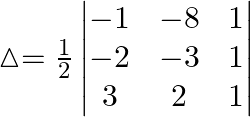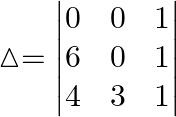(iii) According to the question ![]() ,
, ![]() and
and ![]() are the vertices of the triangle.
are the vertices of the triangle.
We know that if vertices of a triangle are ![]() and
and ![]() , then the area of the triangle is given by:
, then the area of the triangle is given by:

Then putting the value in the above formula,

Expand it along ![]()
![Rendered by QuickLaTeX.com =\frac{1}{2}\left[ -1\left| \begin{matrix} -3 & 1 \\ 2 & 1 \\ \end{matrix} \right|-8\left| \begin{matrix} -2 & 1 \\ 3 & 1 \\ \end{matrix} \right|+1\left| \begin{matrix} -2 & -3 \\ 3 & 2 \\ \end{matrix} \right| \right]](https://www.learnatnoon.com/s/wp-content/ql-cache/quicklatex.com-184f2b06085140b9634232eed5fc7cf3_l3.png) .
.
![]()
![]()
![]()
![Rendered by QuickLaTeX.com =\frac{1}{2}\left[ -1\left| \begin{matrix} -3 & 1 \\ 2 & 1 \\ \end{matrix} \right|-8\left| \begin{matrix} -2 & 1 \\ 3 & 1 \\ \end{matrix} \right|+1\left| \begin{matrix} -2 & -3 \\ 3 & 2 \\ \end{matrix} \right| \right]](https://www.learnatnoon.com/s/wp-content/ql-cache/quicklatex.com-184f2b06085140b9634232eed5fc7cf3_l3.png)
![]()
![]()
![]()
As the area cannot be negative. Hence, ![]() square unit is the area
square unit is the area
Therefore area of triangle is ![]() square units
square units
(iv) As per the qiuestion ![]() ,
, ![]() and
and ![]() are the vertices of the triangle.
are the vertices of the triangle.
We know that if vertices of a triangle are ![]() and
and ![]() , then the area of the triangle is given by:
, then the area of the triangle is given by:

Then, putting the value in above formula

Expanding along ![]()
![Rendered by QuickLaTeX.com =\frac{1}{2}\left[ 0\left| \begin{matrix} 0 & 1 \\ 3 & 1 \\ \end{matrix} \right|-0\left| \begin{matrix} 6 & 1 \\ 4 & 1 \\ \end{matrix} \right|+1\left| \begin{matrix} 6 & 0 \\ 4 & 3 \\ \end{matrix} \right| \right]](https://www.learnatnoon.com/s/wp-content/ql-cache/quicklatex.com-b4be5ef62ea75a72fbd2a10ecea750da_l3.png)
![]()
![]()
![]()
Hence, the area of the triangle is ![]() sq.units
sq.units
